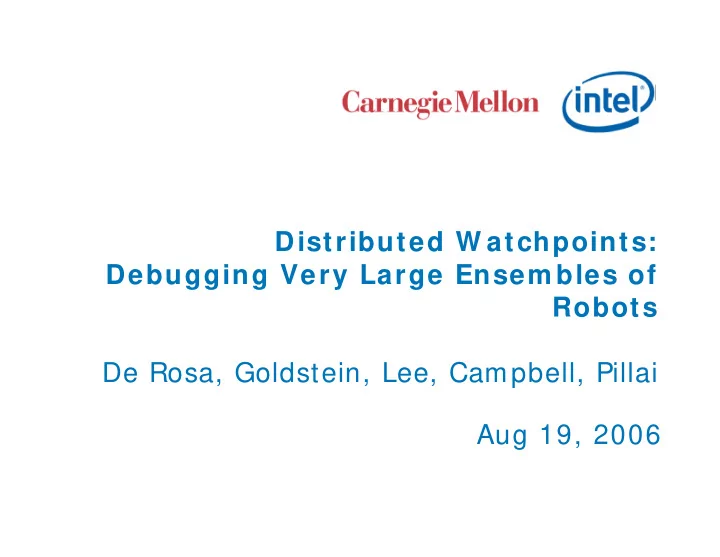

Distributed W atchpoints: Debugging Very Large Ensem bles of Robots De Rosa, Goldstein, Lee, Campbell, Pillai Aug 19, 2006
Motivation • Distributed errors are hard to find with traditional debugging tools • Centralized snapshot algorithms – Expensive – Geared towards detecting one error at a time • Special-purpose debugging code is difficult to write, may itself contain errors 2 8 / 1 9 / 2 0 0 6 Distributed W atchpoints
Expressing and Detecting Distributed Conditions “How can we represent, detect, and trigger on distributed conditions in very large multi-robot systems?” • Generic detection framework, well suited to debugging • Detect conditions that are not observable via the local state of one robot • Support algorithm-level debugging (not code/ HW debugging) • Trigger arbitrary actions when condition is met • Asynchronous, bandwidth/ CPU-limited systems 3 8 / 1 9 / 2 0 0 6 Distributed W atchpoints
Distributed/ Parallel Debugging: State of the Art Modes: • Parallel: powerful nodes, regular (static) topology, shared memory • Distributed: weak, mobile nodes Tools: • GDB • printf() • Race detectors • Declarative network systems with debugging support (ala P2) 4 8 / 1 9 / 2 0 0 6 Distributed W atchpoints
Exam ple Errors: Leader Election Scenario: One Leader Per Tw o-Hop Radius 5 8 / 1 9 / 2 0 0 6 Distributed W atchpoints
Exam ple Errors: Token Passing Scenario: I f a node has the token, exactly one of it’s neighbors m ust have had it last tim estep 6 8 / 1 9 / 2 0 0 6 Distributed W atchpoints
Exam ple Errors: Gradient Field Scenario: Gradient Values Must Be Sm ooth 7 8 / 1 9 / 2 0 0 6 Distributed W atchpoints
Expressing Distributed Error Conditions Requirements: • Ability to specify shape of trigger groups • Temporal operators • Simple syntax (reduce programmer effort/ learning curve) A Solution: • Inspired by Linear Temporal Logic (LTL) – A simple extension to first-order logic – Proven technique for single-robot debugging [ Lamine01] • Assumption: Trigger groups must be connected – For practical/ efficiency reasons 8 8 / 1 9 / 2 0 0 6 Distributed W atchpoints
W atchpoint Prim itives nodes(a,b,c); n(b,c) & (a.var > b.var) & (c.prev.var != 2) • Modules (implicitly quantified over all connected sub-ensembles) • Topological restrictions (pairwise neighbor relations) • Boolean connectives • State variable comparisons (distributed) • Temporal operators 9 8 / 1 9 / 2 0 0 6 Distributed W atchpoints
Distributed Errors: Exam ple W atchpoints nodes( a,b,c) ;n( a.b) & n( b,c) & ( a.isLeader = = 1 ) & ( c.isLeader = = 1 ) nodes( a,b,c) ;n( a,b) & n( a,c) & ( a.token = = 1 ) & ( b.prev.token = = 1 ) & ( c.prev.token = = 1 ) nodes( a,b) ;( a.state - b.state > 1 ) 1 0 8 / 1 9 / 2 0 0 6 Distributed W atchpoints
W atchpoint Execution 1 nodes(a,b,c)… 2 3 2 1 1 9 9 2 1 1 2 3 4 5 6 7 8 � 1 9 10 9 10 11 12 13 14 15 16 . 17 18 19 20 21 22 23 24 . . 25 26 27 28 29 30 31 32 . 1 1 8 / 1 9 / 2 0 0 6 Distributed W atchpoints
Perform ance: W atchpoint Size • 1000 modules, running for 100 timesteps • Simulator overhead excluded • Application: data aggregation with landmark routing • Watchpoint: are the first and last robots in the watchpoint in the same state? 1 2 8 / 1 9 / 2 0 0 6 Distributed W atchpoints
Perform ance: Num ber of Matchers • This particular watchpoint never terminates early • Number of matchers increases exponentially • Time per matcher remains within factor of 2 • Details of the watchpoint expression more important than size 1 3 8 / 1 9 / 2 0 0 6 Distributed W atchpoints
Perform ance: Periodically Running W atchpoints 1 4 8 / 1 9 / 2 0 0 6 Distributed W atchpoints
Future W ork • Distributed implementation • More optimization • User validation • Additional predicates 1 5 8 / 1 9 / 2 0 0 6 Distributed W atchpoints
Conclusions • Simple, yet highly descriptive syntax • Able to detect errors missed by more conventional techniques • Low simulation overhead 1 6 8 / 1 9 / 2 0 0 6 Distributed W atchpoints
Thank You
Backup Slides 1 8 8 / 1 9 / 2 0 0 6 Distributed W atchpoints
Optim izations • Temporal span • Early termination • Neighbor culling • (one slide per) 1 9 8 / 1 9 / 2 0 0 6 Distributed W atchpoints
Recommend
More recommend